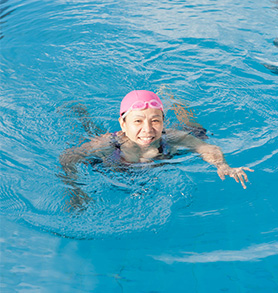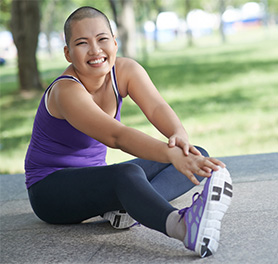Why is it important to be active?
Physical activity is a common coping strategy to reduce uncertainty and move on with everyday living. It is something that you can have control over.

Often, women who have experienced breast cancer are fearful of exercise because of a perceived risk of injuring themselves or pushing themselves too far. Or, they are unsure about how to start. The effects of treatment may have included changes to their physical fitness that have left them feeling tired, anxious, depressed and less inclined to exert themselves. It is important to know that exercise is safe and can provide many health-related benefits, both physical and emotional, after a diagnosis of cancer.

Physical activity can provide the following benefits:
- Reduce treatment side-effects (e.g., fatigue, weight gain)
- Help you feel better emotionally
- Help you regain your energy
- Strengthen your bones and muscles
- Help with managing your weight
- Improve your enjoyment of life

Experts recommend the following amount of exercise:
- 150 minutes of moderate level* aerobic exercise spread over three to five days and resistance training at least two days per week.
- Resistance sessions should involve major muscle groups (e.g., chest, abdomen, arms and lower legs) two to three days per week (eight to 10 muscle groups, eight to 10 repetitions can be a set, two sets a day).
- Each session should include a warm-up and cool down.
* Moderate level exercise is an exercise that makes you breathe harder without feeling out of breath (e.g., brisk walking).
Staying active is also one of the best ways to keep a healthy weight which can be a challenge during and after treatment. People who are overweight run a much higher risk of developing other health problems such as diabetes and heart diseases



-
Consider a variety of types of activity that you enjoy
Three types of physical activity are important for everyone, including women who have experienced breast cancer, and you can try to include all of these in your physical activity plan:
- Cardio exercises such as walking, swimming and dancing.
- Strength and muscular training such as lifting weights.
- Range of motion or stretching exercises such as tai chi and yoga.
-
Exercise with other people
Being active with other people can motivate you and keep you on track. Consider involving your family and friends, or even joining an exercise group or a walking group. -
Start slowly and gradually build up your intensity
When you are ready to begin, start slow and gradually build up intensity as you feel comfortable. Set a goal that you can measure when you start exercising, such as "I will take a 20-minute walk three times a week". Keep a log of time spent, type of activity and frequency you spent each week to track your progress. -
Always warm-up and cool-down
Depending on your exercise, make sure to complete a proper warm-up before and cool-down after your exercise. If you are not sure, speak to a rehabilitation specialist or a fitness instructor. -
Avoid overdoing it
You can avoid overheating by wearing light, breathable clothing and drinking plenty of water throughout your activity. If you feel tired, listen to your body and lower your intensity. -
"It's cold and wet outside" - Ideas on where to exercise in inclement weather:
- Join an indoor mall walking club or a fitness center.
- Sign up for a fitness class or drop-in program at the local community center.
- Borrow a fitness video from your local library.
- Follow an exercise program on cellular phone, TV, or Internet.
Talk to your health care providers

Women with breast cancer can safely engage in moderate amounts of exercise after completion of treatments. If you are unsure about how to start or how far to push yourself, talk to your health care providers. They will be able to help you identify your preferences and limitations. They may also be able to refer you to a cancer rehabilitation or exercise program in your area.
Remember that it is normal for you to have doubts about your physical capabilities. Just start out slow and you will gradually progress to the physical state you want to be in. Recovery takes time. Be patient.
You may find the following brochures to be helpful:
Footnote:
- Exercise guidelines are consistent with the recommendations outlined by the Canadian Society for Exercise Physiology and the American College of Sports Medicine (http://www.csep.ca/en/guidelines/guidelines-for-other-age-groups)
References:
- Exercise for People with Cancer Guideline Development Group, Cancer Care Ontario's Program in Evidence-Based Care (PEBC) https://www.cancercareontario.ca/en
- World Cancer Research Fund International, Diet, Nutrition, Physical Activity and Breast Cancer Survivors Report, 2018. https://www.wcrf.org/
- Kirkham, A. A., Bland, K. A., Sayyari, S., Campbell, K. L., & Davis, M. K. (2016). Clinically Relevant Physical Benefits of Exercise Interventions in Breast Cancer Survivors. Current Oncology Reports, 18(2), 12. doi:10.1007/s11912-015-0496-3
- Segal, R., Zwaal, C., Green, E., Tomasone, J. R., Loblaw, A., & Petrella, T. (2017). Exercise for people with cancer: A clinical practice guideline. Current Oncology, 24(1), 40-46.
- Getting Back on Track, Life After Breast Cancer Treatment, Canadian Breast Cancer Foundation - Ontario / Princess Margaret Hospital, 2010
